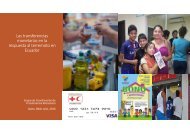Simatelele
2lF850q
2lF850q
Create successful ePaper yourself
Turn your PDF publications into a flip-book with our unique Google optimized e-Paper software.
Zimbabwe – Save the Children<br />
OTHER PRE-PROJECT USES OF MOBILE MONEY<br />
In addition to savings and money transfers, some<br />
EFSP participants reported using mobile money<br />
for other purposes. Eight percent of survey<br />
respondents reported using the service to pay for<br />
goods or services, while 9% reported using the<br />
service to purchase airtime.<br />
CONCLUSIONS: PRE-PROJECT FINANCIAL<br />
SERVICE USE<br />
Prior to the EFSP, Save the Children survey<br />
respondents and FGD participants used a range<br />
of financial management strategies and services,<br />
albeit mostly informal. (87% saved at home, 96% borrowed from family members, and 81% sent/received<br />
money from friends and family, while none of them saved or borrowed through banks or MFIs.) Though<br />
World Bank FINDEX national statistics show that 17% of adults have an account at a formal financial<br />
institution, and 5% have saved at one, it is not surprising that the EFSP recipients are not accessing<br />
formal financial institutions as they represent a more vulnerable population with no regular incomes, and<br />
live in rural, underserved areas. According to the FGD participants, the nearest bank branch was 50-56<br />
kilometers from them – making distance and transportation costs a significant barrier.<br />
EFSP project participants showed some familiarity or experience with mobile money prior to the<br />
project. According to survey results, 25% of respondents had heard of mobile money prior to the<br />
project and 11% had their own mobile money account prior to the project. The leading use of mobile<br />
money was for transferring money (which 20% of respondents reported using), with other participants<br />
reporting mobile money use for purchasing goods or airtime. While no survey respondents reported<br />
borrowing or saving money through mobile money, some focus group participants (as discussed<br />
above), had previously used their accounts to save money while employed and receiving a regular<br />
income. While account ownership rates (11%) are still about half that of the national average (22% of<br />
adults), mobile money has a much higher usage rate than banks or MFIs amongst project participants.<br />
4.2 MOBILE MONEY USE AFTER THE E-TRANSFER PROJECT<br />
The following sections look at changes in mobile money use before and after the EFSP program.<br />
USAGE PATTERNS FOR SPECIFIC MOBILE MONEY SERVICES<br />
Savings<br />
All but 5% (15 survey respondents) reported cashing out their full e-transfer value upon receiving<br />
it from Save the Children. Of the 300 respondents who immediately cashed out all of their full<br />
e-transfer value, nearly all (94%) explained that they needed the cash for household expenditures<br />
while 13% cited reasons related to lack of understanding – either not knowing that it was possible<br />
to keep money in the account (8%) or didn’t know how to use the account (5%). 23 The main driver for<br />
withdrawing the full amount was related to EFSP participants’ immediate consumption needs (in line<br />
with the program design).<br />
23<br />
Multiple responses were allowed.<br />
CAN E-TRANSFERS PROMOTE FINANCIAL INCLUSION IN EMERGENCIES: A CASE STUDY FROM ZIMBABWE 19



